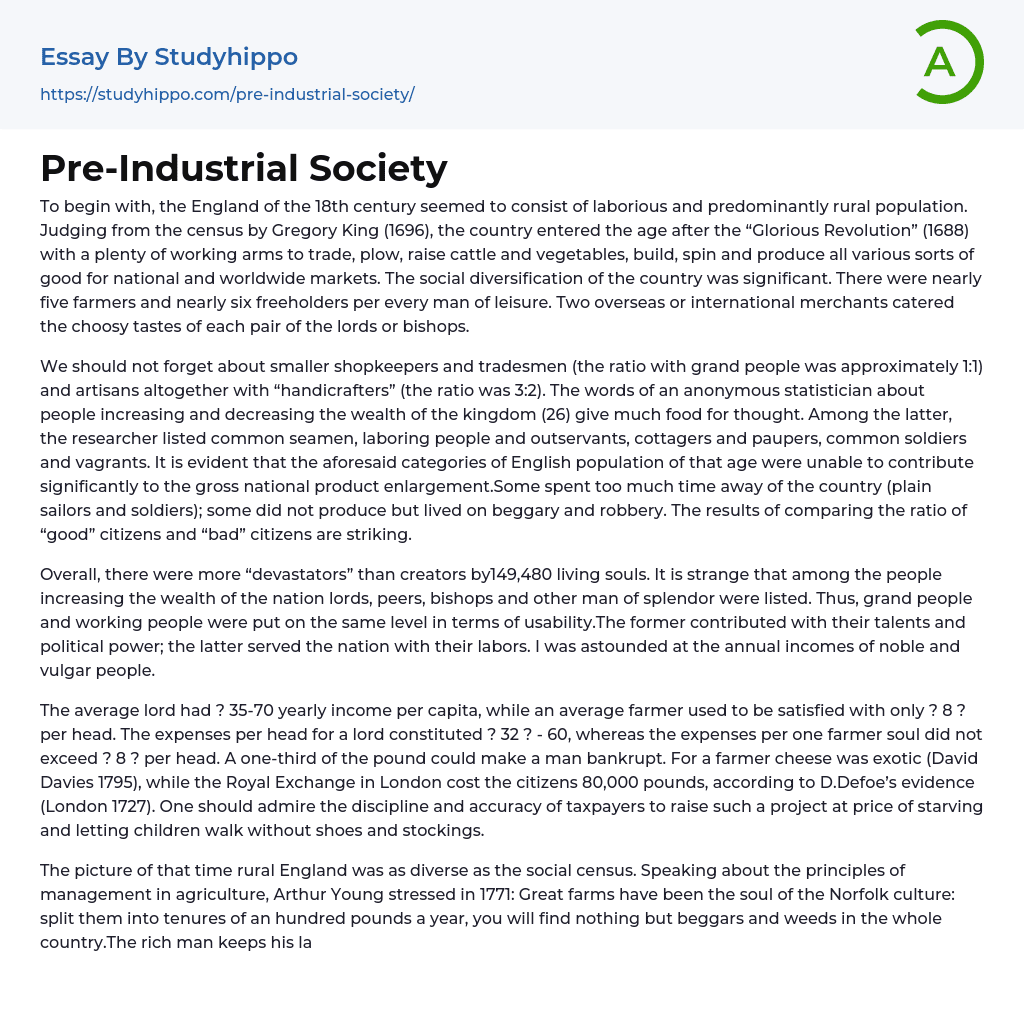Initially, during the 18th century, England appeared to mainly comprise of a diligent and mostly rural populace. Based on Gregory King's census in 1696, following the "Glorious Revolution" in 1688, there was an abundant supply of labor to engage in various trades such as farming, animal husbandry, horticulture, construction, textile production, and the creation of various goods for national and global markets. The country had notable social diversity, with almost five farmers and nearly six freeholders for every gentleman. Additionally, two international merchants served the preference of each pair of lords or bishops.
We must not overlook the smaller shopkeepers and tradesmen, who were in roughly equal numbers to the wealthier members of society, as well as the artisans and "handicrafters," who were in a ratio of 3:2. The words of an anonymous statistician who discussed the people w
...ho contributed to and detracted from the wealth of the kingdom (26) are quite thought-provoking. This individual identified groups such as common seamen, laborers, outservants, cottagers, paupers, common soldiers, and vagrants as being among those who decreased the wealth of the country. It is clear that these categories of English citizens in that time period were unable to significantly contribute to increases in the gross national product. Some were absent from the country too often (such as plain sailors and soldiers), while others did not produce anything and instead lived off begging and stealing. A comparison of the ratio of "good" citizens to "bad" citizens is quite striking.
In total, there were 149,480 more individuals classified as "devastators" rather than "creators". It is peculiar that individuals of wealth and status, such as lords, peers, bishops, and other distinguishe
humans, were included in the category of those contributing to the nation's wealth. This placed both the upper and working classes on equal footing in terms of usefulness - the former bringing their talents and political influence while the latter providing labor. The annual incomes of both the noble and common individuals left me amazed.
The typical income for a lord was approximately ? 35-70 per year per person, whereas an average farmer would be content with ? 8 per person. Per person, lords spent between ? 32 and 60, while farmers' expenses did not surpass ? 8. To give some context, one-third of a pound could lead a man to bankruptcy. Cheese was considered exotic for a farmer in 1795 (according to David Davies), while the construction of the Royal Exchange in London cost citizens a staggering 80,000 pounds (as reported by D.Defoe in London, 1727). It is remarkable to consider the discipline and accuracy of taxpayers who contributed to this project even amidst poverty, causing some children to go barefoot.
In rural England during the time period discussed, the social census brought about a diverse range of pictures. Arthur Young emphasized in 1771 the importance of management principles in agriculture, stating that Great farms were crucial to Norfolk culture. If these farms are divided into tenures of one hundred pounds per year, nothing but beggars and weeds would be found in the entire country. Rich landowners were occupied with selective breeding programs for cattle and soil quality improvement. However, there were also reports of young children starting to work at just four years of age. Daniel Defoe wrote about rural industry in
1724 and claimed that being employed was essential for good health. Unfortunately, he neglected to mention that for children, good health should involve learning and games, rather than manual labour.
Despite Pehr Kalm (1748) and other foreign visitors attempting to highlight England's patriarchal society before the Industrial Revolution, the nation's economy was not hindered. Defoe provided insight into the 18th century clothing trade district, where everyone worked diligently to ensure continuous production. Consequently, the economic focus shifted from agriculture to manufacturing during this era.
- Birmingham essays
- Culture essays
- Social Control essays
- Citizenship essays
- Social Justice essays
- Caste System essays
- Social Responsibility essays
- Socialization essays
- Deviance essays
- Modern Society essays
- Popularity essays
- Civil Society essays
- Community essays
- Female essays
- Filipino People essays
- Igbo People essays
- Indigenous Australians essays
- Indigenous Peoples essays
- Minority Group essays
- Social Institution essays
- Men essays
- The nation essays
- Middle Class essays
- Social Norms essays
- Discourse Community essays
- Popular Culture essays
- Car Culture essays
- American Culture essays
- Mormon essays
- Indian Culture essays
- Mexican Culture essays
- Pop Culture essays
- Cultural Differences essays
- Culture Shock essays
- Different Cultures essays
- Athens essays
- Belgium essays
- Berlin essays
- British essays
- England essays
- Germany essays
- Great britain essays
- Greece essays
- Ireland essays
- Italy essays
- London essays
- Paris essays
- Pompeii essays
- Rome essays
- Russia essays




